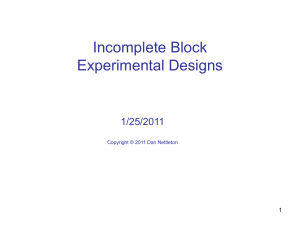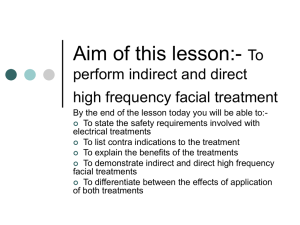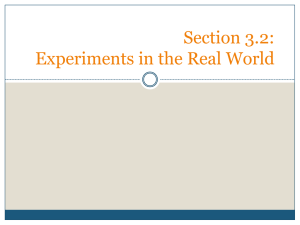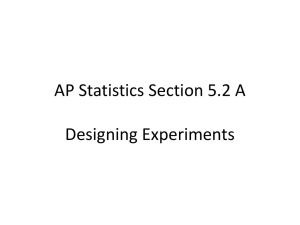Incomplete Block Designs
advertisement
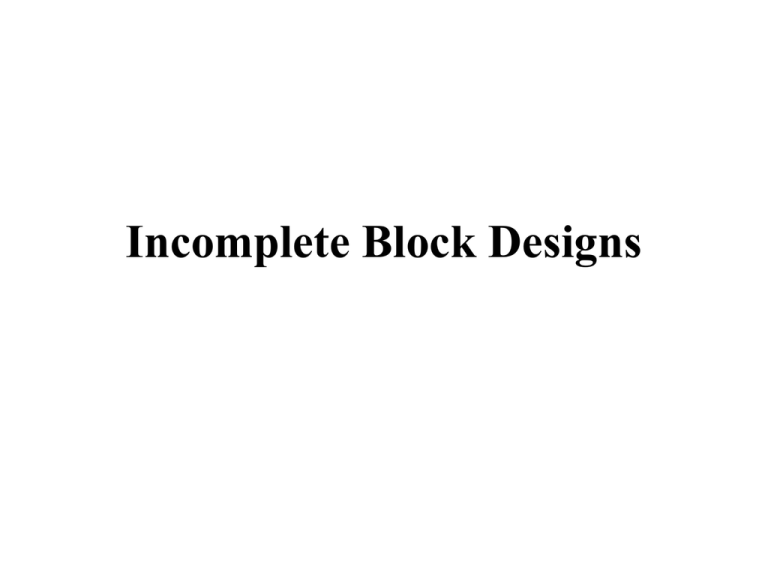
Incomplete Block Designs
Randomized Block Design
• We want to compare t treatments
• Group the N = bt experimental units into b
homogeneous blocks of size t.
• In each block we randomly assign the t treatments
to the t experimental units in each block.
• The ability to detect treatment to treatment
differences is dependent on the within block
variability.
Comments
• The within block variability generally increases
with block size.
• The larger the block size the larger the within
block variability.
• For a larger number of treatments, t, it may not be
appropriate or feasible to require the block size, k,
to be equal to the number of treatments.
• If the block size, k, is less than the number of
treatments (k < t)then all treatments can not appear
in each block. The design is called an Incomplete
Block Design.
Comments
regarding Incomplete block designs
• When two treatments appear together in the
same block it is possible to estimate the
difference in treatments effects.
• The treatment difference is estimable.
• If two treatments do not appear together in
the same block it not be possible to estimate
the difference in treatments effects.
• The treatment difference may not be
estimable.
Example
• Consider the block design with 6 treatments
and 6 blocks of size two.
1
2
1
4
5
4
2
3
3
5
6
6
• The treatments differences (1 vs 2, 1 vs 3, 2
vs 3, 4 vs 5, 4 vs 6, 5 vs 6) are estimable.
• If one of the treatments is in the group
{1,2,3} and the other treatment is in the
group {4,5,6}, the treatment difference is
not estimable.
Definitions
• Two treatments i and i* are said to be connected if
there is a sequence of treatments i0 = i, i1, i2, … iM =
i* such that each successive pair of treatments (ij and
ij+1) appear in the same block
• In this case the treatment difference is estimable.
• An incomplete design is said to be connected if all
treatment pairs i and i* are connected.
• In this case all treatment differences are estimable.
Example
• Consider the block design with 5 treatments
and 5 blocks of size two.
1
2
1
4
1
2
3
3
5
4
• This incomplete block design is connected.
• All treatment differences are estimable.
• Some treatment differences are estimated
with a higher precision than others.
Analysis of unbalanced Factorial
Designs
Type I, Type II, Type III
Sum of Squares
Sum of squares for testing an
effect
SS Effect R SS m odel R educed R SS m odel C om plete
modelComplete ≡ model with the effect in.
modelReduced ≡ model with the effect out.
Type I SS
• Type I estimates of the sum of squares
associated with an effect in a model are
calculated when sums of squares for a model
are calculated sequentially
Example
• Consider the three factor factorial experiment
with factors A, B and C.
The Complete model
• Y = m + A + B + C + AB + AC + BC + ABC
A sequence of increasingly simpler models
1. Y = m + A + B + C + AB + AC + BC + ABC
2. Y = m + A+ B + C + AB + AC + BC
3. Y = m + A + B+ C + AB + AC
4. Y = m + A + B + C+ AB
5. Y = m + A + B + C
6. Y = m + A + B
7. Y = m + A
8. Y = m
Type I S.S.
SS
I
ABC
R SS m odel 2 R SS m odel1
S S B C R S S m o d el 3 R S S m o d el 2
I
SS
I
AC
R S S m o d el 4 R S S m o d el 3
S S A B R S S m o d el 5 R S S m o d el 4
I
S S C R S S m o d el 6 R S S m o d el 5
I
SS
I
B
R S S m o d el 7 R S S m o d el 6
SS
I
A
R S S m o d el 8 R S S m o d el 7
Type II SS
• Type two sum of squares are calculated for an
effect assuming that the Complete model
contains every effect of equal or lesser order.
The reduced model has the effect removed ,
The Complete models
1. Y = m + A + B + C + AB + AC + BC + ABC
(the three factor model)
2. Y = m + A+ B + C + AB + AC + BC (the all
two factor model)
3. Y = m + A + B + C (the all main effects
model)
The Reduced models
For a k-factor effect the reduced model is the all
k-factor model with the effect removed
SS A B C R SS m odel 2 R SS m odel1
II
SS A B R SS Y m A B C A C B C R SS m odel 2
II
SS A C R SS Y m A B C A B B C R SS m odel 2
II
SS B C R SS Y m A B C A B A C R SS m odel 2
II
SS A R SS Y m B C R SS m odel 3
II
SS B R SS Y m A C R SS m odel 3
II
S S C R S S Y m A B R S S m o d el 3
II
Type III SS
• The type III sum of squares is calculated by
comparing the full model, to the full model
without the effect.
Comments
• When using The type I sum of squares the
effects are tested in a specified sequence
resulting in a increasingly simpler model.
The test is valid only the null Hypothesis (H0)
has been accepted in the previous tests.
• When using The type II sum of squares the
test for a k-factor effect is valid only the all kfactor model can be assumed.
• When using The type III sum of squares the
tests require neither of these assumptions.
An additional Comment
• When the completely randomized design is
balanced (equal number of observations per
treatment combination) then type I sum of
squares, type II sum of squares and type III
sum of squares are equal.
Example
• A two factor (A and B) experiment, response
variable y.
• The SPSS data file
Using ANOVA SPSS package
Select the type of SS using model
ANOVA table – type I S.S
Tests of Between-Subjects Effects
Dependent Variable: Y
Ty pe I Sum
Source
of Squares
Correc ted Model 11545. 858a
Intercept
61603. 201
A
3666.552
B
809.019
A*B
7070.287
Error
760.361
Total
73909. 420
Correc ted Tot al
12306. 219
df
8
1
2
2
4
24
33
32
Mean
Square
1443.232
61603. 201
1833.276
404.509
1767.572
31.682
a. R Squared = .938 (Adjusted R Squared = .918)
F
45.554
1944.440
57.865
12.768
55.792
Sig.
.000
.000
.000
.000
.000
ANOVA table – type II S.S
Tests of Between-Subjects Effects
Dependent Variable: Y
Ty pe II
Sum of
Source
Squares
Correc ted Model 11545. 858a
Intercept
61603. 201
A
3358.643
B
809.019
A*B
7070.287
Error
760.361
Tot al
73909. 420
Correc ted Tot al 12306. 219
df
8
1
2
2
4
24
33
32
Mean
Square
1443.232
61603. 201
1679.321
404.509
1767.572
31. 682
a. R Squared = .938 (Adjusted R Squared = .918)
F
45. 554
1944.440
53. 006
12. 768
55. 792
Sig.
.000
.000
.000
.000
.000
ANOVA table – type III S.S
Tests of Between-Subjects Effects
Dependent Variable: Y
Ty pe III
Sum of
Source
Squares
Correc ted Model 11545. 858a
Intercept
52327. 002
A
2812.027
B
1010.809
A*B
7070.287
Error
760.361
Tot al
73909. 420
Correc ted Tot al 12306. 219
df
8
1
2
2
4
24
33
32
Mean
Square
1443.232
52327. 002
1406.013
505.405
1767.572
31. 682
a. R Squared = .938 (Adjusted R Squared = .918)
F
45. 554
1651.647
44. 379
15. 953
55. 792
Sig.
.000
.000
.000
.000
.000
Incomplete Block Designs
Balanced incomplete block designs
Partially balanced incomplete block
designs
Definition
An incomplete design is said to be a Balanced
Incomplete Block Design.
1. if all treatments appear in exactly r blocks.
• This ensures that each treatment is estimated with
the same precision
• The value of l is the same for each treatment pair.
2. if all treatment pairs i and i* appear together in exactly
l blocks.
• This ensures that each treatment difference is
estimated with the same precision.
• The value of l is the same for each treatment pair.
Some Identities
Let b = the number of blocks.
t = the number of treatments
k = the block size
r = the number of times a treatment appears in the
experiment.
l = the number of times a pair of treatment appears together
in the same block
1. bk = rt
•
Both sides of this equation are found by counting the
total number of experimental units in the experiment.
2. r(k-1) = l (t – 1)
•
Both sides of this equation are found by counting the
total number of experimental units that appear with a
specific treatment in the experiment.
BIB Design
A Balanced Incomplete Block Design
(b = 15, k = 4, t = 6, r = 10, l = 6)
B lock
1
4
B lock
6
1
2
3
2
1
4
3
2
4
5
6
B lock
11
3
4
5
1
3
5
6
5
6
7
1
2
3
6
12
2
3
4
6
3
4
6
8
1
3
4
5
13
1
2
5
6
1
2
3
5
9
2
4
5
6
14
1
3
4
6
1
2
4
6
10
1
2
4
5
15
2
3
4
5
An Example
A food processing company is interested in comparing the
taste of six new brands (A, B, C, D, E and F) of cereal.
For this purpose:
• subjects will be asked to taste and compare these
cereals scoring them on a scale of 0 - 100.
• For practical reasons it is decided that each subject
should be asked to taste and compare at most four of
the six cereals.
• For this reason it is decided to use b = 15 subjects and
a balanced incomplete block design to assess the
differences in taste of the six brands of cereal.
The design and the data is tabulated below:
Analysis for the Incomplete Block Design
Recall that the parameters of the design where
b = 15, k = 4, t = 6, r = 10, l = 6
B lock T otals
j
1
2
3
4
5
6
7
8
9
10
11
12
13
14
15
G
Bj
258
213
258
198
170
245
225
311
168
245
199
247
228
241
316
3522
T reat T otals and E stim ates of T reatm ent E ffects
T reat
T reat T otal (T i)
j(i) B j /k
D iff = Q i
T reat E ffects ( i)
(A )
(B )
(C )
(D )
(E )
(F)
501
600
795
821
571
234
572
578.25
624.5
603.5
595.25
548.5
-71
21.75
170.5
217.5
-24.25
-314.5
-7.89
2.42
18.94
24.17
-2.69
-34.94
j ( i ) denotes summation over all blocks j containing treatment i.
i
Qi
t 1
Anova Table for Incomplete Block Designs
Sums of Squares
yij2 = 234382
Bj2/k = 213188
Qi2 = 181388.88
Anova Sums of Squares
SStotal = yij2 –G2/bk = 27640.6
SSBlocks = Bj2/k – G2/bk = 6446.6
SSTr
= ( Qi2 )/(r – 1) = 20154.319
SSError = SStotal - SSBlocks - SSTr = 1039.6806
Anova Table for Incomplete Block Designs
Next Topic: Designs for
Estimating Residual Effects
